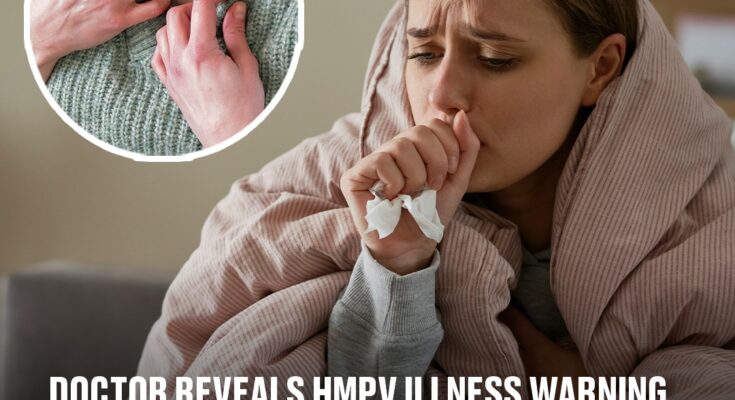
A doctor has come out to share a sign of the HMPV virus that you can spot on your skin.
Experts recently warned that people need to be aware of the illness that can be a ‘severe disease’ for people who are most at risk after growing cases of HMPV were confirmed in China India, Kazakhstan, and Malaysia.
Half a decade since the worldwide outbreak of Covid-19 has passed, and it’s only normal that people would be wary of another pandemic after hearing out this little known illness.
However, the human metapneumovirus, aka HMPV, first surfaced 24 years ago in 2001, and comes and goes throughout the year.
While there’s no need to panic, it can be severe for people who have lung conditions, immune compromised, are elderly or are children.

HMPV can be severe in some people (Getty Stock Image)
It can develop into pneumonia and even exacerbate asthma and chronic obstructive pulmonary disease (COPD), as per The Telegraph.
Professor Paul Griffin, director of infectious diseases at Mater Health Services in Brisbane, told the Guardian: “It certainly can and does cause severe disease, that’s why I think it’s important that people know it’s out there.”
He said: “The challenge is at the moment there’s not much we can do except educate people [that] it’s around to reduce transmission. There’s no vaccine or antivirals, although there are some vaccines in development.”
This is why if you notice the signs and you fall under the above categories, taking precautions and taking care of yourself is key.
But apart from the usual sneezing, coughing, and wheezing, there’s something else you could be missing that signifies that you are ill before the overt signs.
It could begin as a rash.
Paul Hunter, who is a professor at the University of East Anglia, told The Telegraph: “It’s a totally different virus from flu, which mutates faster. All viruses mutate and evolve, but flu is the quickest to do so and the symptoms of flu are far more severe.”

A rash could be a sign (Getty Stock Image)
In 2013, a study found that around five to ten percent of kids with HMPV presented with a rash, which could be a separate issue, but if you are tested, you could know for sure whether it’s HMPV.
According to Hunter, if you think you have HMPV, you should get medical help immediately, particularly if you experience a high fever a blue hue on your skin, nails or lips or breathing difficulties.
It’s important to note that’s there’s no cure per se, but you can be treated in hospital if your symptoms become severe.
The good news? There are so many children that get HMPV before they turn five and onwards.
Hunter told the BBC: “Almost every child will have at least one infection with HMPV by their fifth birthday and we can expect to go onto to have multiple reinfections throughout life.
“So overall, I don’t think there is currently any signs of a more serious global issue.”
If you notice any strange rash and feel under the weather, it’s best to speak to your GP about possible causes, even if it isn’t HMPV.

The human body has many ways of letting us know if something isn’t quite right, and listening to it is essential.
If you don’t, you could be letting something brew inside of you with potentially fatal consequences.
For example, do you know the signs skin changes could be trying to tell you?
Your skin holds so many clues to what could be going on beneath the surface, from vitamin deficiencies to other things like jaundice (liver issues) and so much more.

Checking your skin could help you catch serious conditions early. (Getty Stock Images)
But this one symptom may not be as obvious because it doesn’t hurt and seems pretty harmless upon first inspection.
Thankfully, an NHS doctor has come out to explain what this skin condition could mean and it’s not something you want to let spiral out of control.
Dr Renée Hoenderkamp has said that a painless skin condition could mean you have high cholesterol.
But it doesn’t stop there.
It can also mean you have high blood pressure, which puts you at a higher risk for heart diseases and other issues.
The GB News resident doctor said that monitoring your skin could mean that you catch these symptoms early.
She said: “You can get yellowish-orange growths on your skin if your cholesterol levels are high.”

A skin symptom could point to high cholesterol and blood pressure. (Getty Stock Image)
She explained that they are cholesterol deposits under your skin.
According to Patient.info, if they are on your eyelids, they’re known as xanthelasma and can slowly grow in size.
The website states: “The appearance of xanthelasma is of yellow flat plaques over the upper or lower eyelids, most often near the inner canthus.”
It continues: “Xanthelasma may represent a localised skin condition without any systemic abnormalities of lipoprotein metabolism or may be associated with an increase in the cholesterol-rich beta-lipoproteins (LDLs).”
But treatment is possible and includes a better diet.
The site states that: “Patients should have their fasting lipid levels checked and those with hyperlipidaemia should have a formal cardiovascular risk assessment using appropriate charts, with measures for prevention of cardiovascular disease as indicated.”

Xanthelasma are fatty cholesterol deposits under the skin. (Getty Stock Images)
According to the American Osteopathic College of Dermatology, “about half of patients with xanthelasma have elevated lipid levels that are commonly associated with hereditary forms of high cholesterol or certain liver diseases. The other half of patients have normal cholesterol levels. Xanthelasma are more commonly associated with patients of Asian or Mediterranean descent.”
However, if they appear anywhere else other than the eyelids, they are called xanthoma instead.
Dr Hoenderkamp explained that they are painless and can appear in other areas than the eyelid, but it can appear as a sudden emergence of bumps across the skin which can even look like a rash.
But don’t mistake it for a rash, as they are fatty cholesterol deposits caused by high levels of triglycerides in the blood.
She said: “Triglycerides is often high in familial hypercholesterolaemia.”
To treat them, ‘removal include chemical peels, surgery, lasers, or cryotherapy. However, recurrence is common especially in those patients with hereditary forms of high cholesterol,’ as per the AOCD.

It’s easy to look at your face everyday and brush off what you might think are common ailments, but it could mean you’re missing some worrying symptoms.
Thankfully, a doctor has come out to reveal five signs of serious health problems that all present themselves in your facial area.
Dr Donald Grant, GP and Senior Clinical Advisor at The Independent Pharmacy told The Mirror that these signs could range anywhere from a vitamin deficiency to serious liver disease, and that changes in the face can mean bad things for your health.
Dr Grant explained: “From vitamin deficiency to liver disease, our faces can often signify a range of health issues. Understanding how the face can indicate health is an effective way of spotting conditions early and receiving the best treatment.”
Here’s what you need to keep an eye on:
A puffy or swollen face
If you’ve been feeling a little puffy and sore, it could be an issue.
Dr Grant explained that ‘facial swelling can often be a sign of minor health issues such as hay fever or other allergic reactions. However, puffy faces may also indicate fluid retention – a common sign of kidney complications.’
He added: “A swollen face could also be a sign of conditions such as cellulitis, a skin infection that makes the skin appear red and swollen. This infection can occur all over the body, including on the face. To treat cellulitis, a GP can prescribe antibiotics with the infection usually clearing up after around a week of treatment.”

Do you have a persistent rash? Get it checked out. (Getty Stock Images)
Pale skin
He’s not talking about us gingers…
The doctor said that ‘chronic illnesses, poor diet or vitamin deficiency can all lead to paleness in the skin.’
He explained: “This is often due to a lack of red blood cells or haemoglobin, leading to discolouration in the face. If you’re suffering from pale skin, incorporate iron-rich foods into your diet such as red meat, beans and lentils.”
Yellow skin or eyes
If you’ve woken up looking like a lemon, there’s a serious reason.
Dr Grant shared that if they become yellow it could be ‘an indicator of jaundice’.
He explained that jaundice occurs when ‘the amount of bilirubin builds in the body. Jaundice can be caused by a range of health issues such as liver disease, hepatitis or sickle cell disease.’
“As jaundice can signify a range of health implications, it’s crucial to seek medical advice from a qualified GP to understand the root causes behind the facial changes,” Dr Grant added.

Maybe your dry skin isn’t a weather issue. (Getty Stock Images)
A rash
Rashes can be a bother, but if it doesn’t go away, it could spell trouble.
“Persistent rashes on the face may indicate lupus, an autoimmune disease. These rashes tend to appear on the nose and cheeks before spreading to the arms and chest,” he said.
The doc shared: “Lupus is a long-term condition that can be diagnosed through blood tests, it’s essential to seek urgent medical attention if you feel you may have developed this disease. Aside from lupus, a facial rash could be a sign of allergies or rosacea.”
Dry lips or skin
When your ChapStick doesn’t work like it used to for your lips, maybe it’s more than just changing seasons causing your issue.
Dr Grant said: “Lastly, while dry lips or skin can often be a sign of changing weather conditions or ageing, it’s also caused by dehydration. Signs of dehydration include flushed skin, dry cough, thirst and dark yellow pee. It’s important to maintain a healthy water intake throughout the day, adjusting accordingly when temperatures start to rise.
“Overall, it’s important to be aware of the different health indicators our faces provide. By understanding the common signs of illness or infection, people can receive early medical treatment to minimise symptoms.”

Experts have warned that people need to be aware of a little known winter illness that can cause ‘severe disease’ for people who are most at risk.
Growing cases of HMPV illnesses have been confirmed with China seeing increasing cases of the illness, as well as India, Kazakhstan and Malaysia.
Now that it has been five years since the worldwide outbreak of Covid-19, it’s understandable that people would be trepidatious about another round of potential contagions.
But the human metapneumovirus, aka HMPV, has been around for years, having first surfaced 24 years ago in 2001, and similar to the flu, comes in peak flu season throughout winter and spring as well as being spread through sneezing, coughing, or contact with contaminated surfaces.
HMPV symptoms
.jpg)
HMPV was first discovered in 2001 (Getty Stock Images)
HMPV is a seasonal illness which has been seen across the globe for years, and because of this, there is more resistance among the general population, The Independent says.
But for some people who do get it, it could lead to health complications.
According to Public Health Scotland, you can expect to see coughing, a high temperature and a runny nose three to six days after being infected.
However, those who are more at risk could see more severe symptoms.
Who is most at risk from HMPV?
Professor Paul Griffin, director of infectious diseases at Mater Health Services in Brisbane, told the Guardian: “It certainly can and does cause severe disease, that’s why I think it’s important that people know it’s out there.”
Children, the elderly or those who are immunocompromised could experience issues such as bronchitis, bronchiolitis and pneumonia and flare ups for chronic obstructive pulmonary disease (COPD), which may require hospital treatment.
This is the same for people who already have lung conditions like asthma.
Pro Griffin says: “The challenge is at the moment there’s not much we can do except educate people [that] it’s around to reduce transmission. There’s no vaccine or antivirals, although there are some vaccines in development.”
How can you protect yourself and others from HMPV?
.jpg)
Some people are at risk of serious illness (Getty Stock Image)
Professor Jaya Dantas at Curtin University in Australia explained that to protect yourself, you can ‘wear a mask in public’ and stay away from others to protect the vulnerable people mentioned above.
“In young children, the elderly and those who are immune compromised, HMPV can lead to severe cases and can move to the lower respiratory tract and may lead to pneumonia,” the expert added.
Jonathan Ball, who works at Liverpool School of Tropical Medicine, also shared: “HMPV has been known about since 2001, and has been circulating in humans for at least 50 years – probably a lot longer.
“Unfortunately, it is associated with pneumonia, particularly in young children, but this is thankfully rare.”
Lastly, Professor Paul Hunter from the University of East Anglia, added: “Almost every child will have at least one infection with HMPV by their fifth birthday and we can expect to go on to have multiple reinfections throughout life.
“It is one of the leading viral causes of respiratory infections in children under five-year-olds.”
It’s important to know that most kids aged five and under have already caught HMPV at one point or another and according to the Cleveland Clinic, once you’ve had it, the next time is likely to be more mild.
Foreign ministry spokesperson Mao Ning said on Friday 3 January: “Respiratory infections tend to peak during the winter season.
“The diseases appear to be less severe and spread with a smaller scale compared to the previous year.”

The people nearest and dearest to you aren’t always rainbows and sunshine, but sometimes your significant other’s behaviour should set off alarm bells.
When we think about the term narcissist, we might conjure up images of a person who is overt in the way that they present themselves, making it clear to see who is and who isn’t a narcissist.
But it’s a lot more complex than that.
According to a toxic relationship recovery coach called Christina who runs the YouTube channel Common Ego, there are 12 red flags to be wary of.

Christina offered some invaluable advice (YouTube/Common Ego)
If you spot them, it might be time to have a conversation or make a difficult choice about ending the relationship.
She said: “They gaslighted, manipulated you, told you that you were too much and not enough in the same breath.
“And the worst part? They left you questioning whether they were right.”
However, by following the 12 signs of what you’ll see early on in the relationship leading to further on down the line, she shared how you can realise that they are wrong about you and how to break free.
They love bomb you
‘The love bomb phase, aka the too good to be true phase’, is ‘unlike anything you’ve ever experienced’ as they bombard you with praise and affection constantly.
But it’s not genuine.
It can be hard to figure out if you’re really being manipulated as you try to brush off your fears, but Christina says that they are using ‘flatter to get what they really want’ from you, which is typically your affection.

The love bombing never lasts (Getty Stock Image)
They mirror you
Mirroring is an act of essentially copying another person’s mannerisms, the way they talk and take on their personality of their own as a way to appear more likeable.
Or as though they have a connection with you like no other person.
Christina says: “Every interest you have becomes their passion. That childhood story you thought no one would understand, suddenly it feels like a shared experience.”
For a narcissist, it’s a way to force a connection.
They press fast-forward
A big thing that’s typical in this type of dynamic, is when your relationship goes from 0 to 100 right away.
You just met but now you’re moving in together, are planning a wedding and now want children together.
While it might feel like you’ve met your true love within two weeks, it’s unlikely to be the case.
Christina warns that it’s their way to get their hooks into you so that you can’t break the connection easily.
They’ll put you down using jokes
Being made fun of isn’t nice for anyone, particularly if it’s coming from your spouse.
But Christina notes that this is all part of the ‘devaluation stage’ where your partner may begin to tell you what they really think about you and disguise it as a joke, leaving you feeling unsure of how to react or feel.
Christina says: “There’s a whole lot of plausible deniability behind this one. They can just say, ‘Oh, it was just a joke, I didn’t mean it.’
“Narcissists often use humour to test your boundaries. Give them an inch and they will take a mile.”

The devaluation phase follows being love bombed (Getty Stock Image)
They have double standards
While they might ‘grill you’ on what you did with friends or ‘why you took so long’ to text back, they won’t allow you to do the same to them.
The expert then shared that they’ll use this to isolate you from those you love as you try to keep the peace.
They have a victim complex
While they might always need something from you or need more and more kindness from you when they feel down, it’s actually due to playing the victim and stealing your effort and time.
Christina said: “The problem here is when the sunk cost fallacy comes into play. You think about all the time you invested in helping this person, and if you walk away now all that time was for nothing.”
They begin gaslighting
Now, you’re deep into the ‘devaluation phase’ where it happens so gradually, that you probably won’t even notice.
Unfortunately, it gets so bad that you feel like you’re going crazy and have to prove that what happened…happened.
Christina said that this might be their goal, to make you feel crazy and that you’re lashing out at them when you double down on your side of the story.

Narcissists have many ways to manipulate you (Getty Stock Image)
They attack your feelings
They’ll tell you that you’re ‘too sensitive’ or that you’re ‘feeling something that you’re not’, as a way to make you feel insane. This could mean telling you you’re angry or jealous when you’re actually not.
Christina says: “No one has the right to tell you what or how much to feel.”
They re-write history
Re-writing history is something that Christina says is part of a narcissist’s gaslighting arsenal, where they will poke the bear to see how they can make you react and then tell you that you reacted over nothing and that you attacked them instead.
They are entitled
According to Christina, ‘any narcissist who doesn’t get their way is going to throw a fit’.
Christina says: “When you don’t give them something they think is rightfully theirs, they’re going to punish you.”
They lack empathy
Now, while this is a complex and controversial topic, Christina believes that a lack of empathy is something that she sees often, and it’s not something you want to be around.
They are jealous
Whether this is because someone looks better than them or is more successful than them, they can be jealous of anything and anyone.
Christina says: “When someone else is ‘winning’, the narcissist may go out of their way to sabotage that person. It could be something as simple as bad mouthing someone at a party because they look better or are getting more attention.”
While narcissism is something that you need to watch out for, it is a personality disorder that a person might not be aware of the pain they are inflicting.
So maybe approaching your exit with feedback is a good idea to drill it into them.



